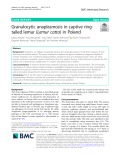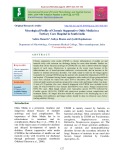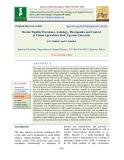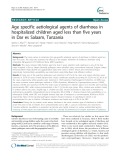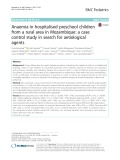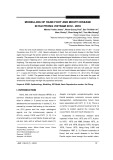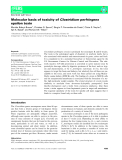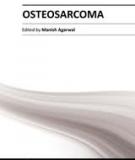
Aetiological agents
-
Anaplasma are obligate intracellular bacteria and aetiological agents of tick-borne diseases of both veterinary and medical interest. The genus Anaplasma comprises six species: Anaplasma marginale, Anaplasma centrale, Anaplasma ovis, Anaplasma phagocytophilum, Anaplasma bovis and Anaplasma platys.
 5p
5p  vidarwin
vidarwin
 23-02-2022
23-02-2022
 9
9
 1
1
 Download
Download
-
Eye is a complex and sensitive organ and is therefore more vulnerable to trauma and various infections. Indian population is vulnerable to infections of eye by virtue of subtropical climate, trauma and iatrogenic procedures. Infectious endophthalmitis is a threatening and potentially devastating intra ocular infection caused by an array of organisms.
 6p
6p  nguaconbaynhay7
nguaconbaynhay7
 15-08-2020
15-08-2020
 16
16
 1
1
 Download
Download
-
Chronic suppurative otitis media (CSOM) is chronic inflammation of middle ear and mastoid cavity with recurrent ear discharge lasting for more than 6months. Studies are mainly done on the bacterial aetiology of CSOM, but very little is known about the fungal aspects of such cases. Otomycosis is increasing in the recent years because of the indiscriminate use of broad-spectrum antibiotics, corticosteroids, and an increase in the number of immune deficiency disorders.
 6p
6p  nguaconbaynhay6
nguaconbaynhay6
 24-06-2020
24-06-2020
 14
14
 0
0
 Download
Download
-
Human immunodeficiency virus (HIV) is a retro virus known to be the primary aetiological agent of Acquired Immunodeficiency syndrome (AIDS). It is reported that about 39 million people globally are living with HIV. HIV infected patients are frequently present with elevated levels of serum alanine aminotransferase (ALT) and aspartate aminotransferase (AST). This has been often attributed to the hepatic effects of Antiretroviral- Protease Inhibitor drugs (PI’s).
 7p
7p  nguaconbaynhay6
nguaconbaynhay6
 23-06-2020
23-06-2020
 8
8
 1
1
 Download
Download
-
The study was accomplished to evaluate bovine mastitis therapeutics and control in Tatton Agriculture Park (TAP), Egerton University. Causative agents were investigated through culture and identification then subjected to commonly used antimicrobials to determine their sensitivity hence identify drug of choice.
 10p
10p  kethamoi5
kethamoi5
 03-06-2020
03-06-2020
 9
9
 0
0
 Download
Download
-
Candida albicans is the most common aetiological agent in candiduria cases commonly observed in hospitalized patients. But a few reports are available from India where non albicans Candida species have accounted for >50 per cent of urinary Candida isolates. We undertook this study to know the Candida species profile amongst candiduria cases. A total of 119 consecutive Candida isolates obtained from clinically suspected cases of urinary tract infection from January 2016 to June 2017 (18 months), were included.
 9p
9p  caygaocaolon5
caygaocaolon5
 27-05-2020
27-05-2020
 13
13
 1
1
 Download
Download
-
This study aimed to determine the age-specific aetiologic agents of diarrhoea in children aged less than five years. The study also assessed the efficacy of the empiric treatment of childhood diarrhoea using Integrated Management of Childhood Illness (IMCI) guidelines.
 6p
6p  virubber2711
virubber2711
 21-03-2020
21-03-2020
 8
8
 2
2
 Download
Download
-
Young children bear the world’s highest prevalence of anaemia, the majority of which is of multifactorial aetiology, which in turn hampers its successful prevention. Even moderate degrees of anaemia are associated with increased mortality and morbidity.
 10p
10p  videshiki2711
videshiki2711
 19-02-2020
19-02-2020
 14
14
 2
2
 Download
Download
-
The incidence rate was 106 cases per 100,000 population. The age-specific incidence rate for Hand, foot and mouth disease was highest in the age group of 1 - 3 years old (75.04%). The major aetiologic agents were EV - 71 (52.6%), CV - A6 (21.8%). R0 ranged from 1.0077 - 2.4883. The greatest burden of Hand, foot and mouth disease is in the under five years old age range. Under present conditions, hand, foot and mouth disease will continue to persist in Haiphong. Interventions should target the high risk populations and areas.
 12p
12p  nguyentuananh2502
nguyentuananh2502
 03-04-2019
03-04-2019
 29
29
 0
0
 Download
Download
-
Clostridium perfringense-toxin is produced by toxinotypes B and D strains. The toxin is the aetiological agent of dysentery in newborn lambs but is also associated with enteritis and enterotoxaemia in goats, calves and foals. It is considered to be a potential biowarfare or bioterrorism agent by the US Government Centers for Disease Control and Prevention.
 13p
13p  cosis54
cosis54
 04-01-2013
04-01-2013
 69
69
 8
8
 Download
Download
-
The pathogenesis of osteomyelitis is a complex process involving interactions between a host and an infectious agent. The host’s inflammatory response to a pathogen can further the physical spread of disease by clearing space in bone. Predisposing genetic differences in immune function are increasingly seen as an aetiological factor in some cases of osteomyelitis. Acquired factors such as diseases causing immune or vascular compromise and implantation of foreign materials are frequently involved in the disease process as well. ...
 182p
182p  wqwqwqwqwq
wqwqwqwqwq
 20-07-2012
20-07-2012
 90
90
 9
9
 Download
Download
-
Bacterial biofilms are regarded to be the primary aetiological factor in the initiation of gingival inflammation and subsequent destruction of periodontal tissues (Offenbacher 1996) and three major specific pathogens have been repeatedly identified as etiologic agents, namely Aggregatibacter (Actinobacillus) actinomycetemcomitans (Aa), Porphyromonas gingivalis (Pg) and Tannerella forsythia (Tf) (Socransky et al. 1998).
 28p
28p  pt_1669
pt_1669
 27-03-2012
27-03-2012
 400
400
 145
145
 Download
Download
CHỦ ĐỀ BẠN MUỐN TÌM








